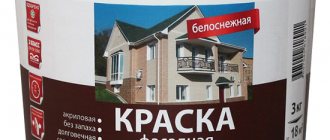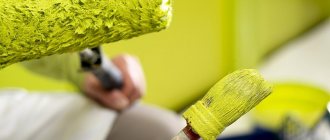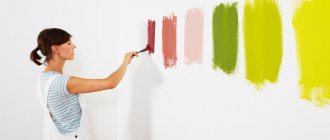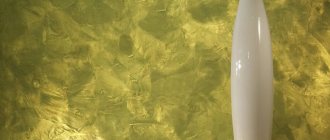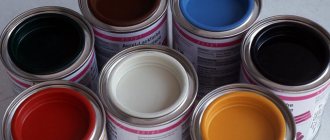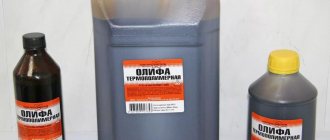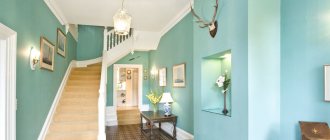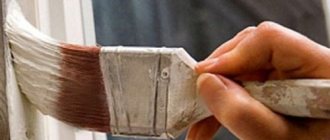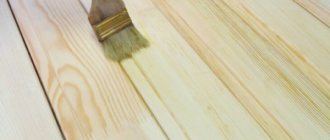SHARE ON SOCIAL NETWORKS
FacebookTwitterOkGoogle+PinterestVk
When performing renovation work in a private house, apartment or country house using natural materials, the best option for processing them is acrylic paint for wood. This water-based composition is easy and quick to apply, reliably protects the surface from the effects of adverse factors, while simultaneously giving it a decorative appearance. You can learn about the distinctive features of paint and the rules for choosing it from this article.
Acrylic paint for wood is easy to apply and dries quickly
What is acrylic paint: distinctive features of the composition
Acrylic paint is one of the types of water-based compositions. It replaced the oil coating. This paint is characterized by high performance qualities, thanks to which it provides reliable and durable protection of the wooden surface, giving it an aesthetically pleasing decorative appearance.
Acrylic compositions are water-based, they are characterized by reliability and durability
A distinctive feature of this composition is the water-solubility of the material, due to which the paint can be removed with water until the surface is completely dry. After the paint has completely set, it forms a protective, durable, moisture-resistant layer that is characterized by good elasticity. This feature allows the surface not to react to temperature changes and fluctuations in air humidity.
Possessing a unique composition, acrylic paints are characterized by a rich, bright palette of shades that do not fade or fade over time. The material can create a matte or glossy surface. There are also paints that imitate wood, satin or velvet. In addition, certain components eliminate the likelihood of cracking of the painted surface. The demand for this composition is also explained by the lack of toxicity and safety for human health.
Important! There is acrylic paint of a transparent color, thanks to which it will be possible not only to protect the surface, but also to emphasize its unique texture and natural shade.
Advantages of buying paints at TBM-Market
offers its clients:
- High-quality paints and varnishes at affordable prices.
- Effective consultation that will help you choose the right products.
- Free delivery of orders when purchasing goods worth more than 3,000 rubles. Pickup available.
- Convenient ways to pay for products. The goods can be paid in cash at the office cash desk or to the courier forwarder. Payment by card and through other payment systems is accepted.
Choose the best paint for wood surfaces. Buy from the largest supplier in your region. To place an order, call TBM-Market right now.
Acrylic paint for wood: advantages and disadvantages of the composition
Acrylic on wood has the advantages of oil and watercolor paint. It is odorless and does not contain harmful toxic components. The material is characterized by a high level of adhesion to the treated surface and good hiding power, which ensures economical consumption of the composition. It is enough to apply the paint in two layers to obtain a uniformly and densely painted surface. Thanks to its water solubility, the paint is easy and safe to work with, and there is no need to use solvents.
Such paints are durable and resistant to mechanical stress.
Helpful advice! The paint can be diluted with water and tinted with your own hands using special dyes that are intended specifically for acrylic compositions.
The dried surface is durable, resistant to mechanical stress and various adverse environmental influences. The coating is characterized by fire safety. The surface is easy to care for. It can also be sanded.
The base, due to the elasticity of the surface, does not crack and retains its original appearance for many years. The hydrophobicity of the coating allows you to promptly remove excess moisture from the surface, while extending the service life of wooden structures.
The surface treated with acrylic paint dries quickly. The maximum period is 3-4 days, which depends on the type of wood, the quality of base preparation and environmental conditions. Acrylic paint can be used for both interior and exterior applications. It can also be used to paint wood-containing materials such as chipboard, fibreboard, OSB and plywood.
Acrylic paints are odorless and can be diluted with water.
The disadvantages of acrylic paint for wood include the high cost of the material, insufficient level of vapor permeability, which can lead to peeling of the coating if the composition was applied to damp wood. Paint cannot be stored at subzero temperatures.
How to choose quality products for painting wood
To avoid the question of whether it is possible to paint wood with acrylic paint so that it does not lose its original aesthetic appearance, it is important to choose high-quality products that must meet European standards. The paint should not contain toxic components and emit an unpleasant odor during operation. Therefore, when choosing good products, it is better to give preference to formulations from well-known manufacturers who provide a certificate for their products.
The leading position in the world market for the production of acrylic enamel for wood is occupied by the Finnish company Tikkurila. Such compositions are of high quality, provide reliable protection of the wooden surface from the negative effects of the sun, snow, rain, preventing the process of wood rotting.
On a note! To obtain the most protected coating, it is recommended to apply the paint in 3 layers.
When buying acrylic paint for wood, you need to pay attention to its shelf life.
Acrylic paint compositions from the German manufacturer Dufa are in demand. Good quality products at an affordable price are offered by companies such as Pinotex ultra (Estonia), Belіnka (Slovenia), Dulux (UK). Acrylic paint from domestic manufacturers, which include Yaroslavl Paints, Aquatex, and Drevoplast, is characterized by an acceptable price-quality ratio.
Components of acrylic paint on wood
The basis of acrylic paint is acrylic acid or emulsion, which consists of polyacrylic, polymethacrylic, water and coloring pigment. The acrylic component plays the role of a binder that connects water and color, providing a set of necessary properties that distinguish two-component water-based acrylic compositions.
The coloring pigment is represented by a fine powder, which not only gives a certain color to wood paint, but also provides the composition with increased strength. This color scheme, which is used for acrylic compositions, is characterized by a rich color palette.
The composition of such paints includes coloring pigments, polymethacrylic, polyacrylic and water
In addition to the main components, acrylic paint also contains other additional elements. The presence of plasticizers gives the solution the necessary elasticity, due to which, after painting the surface, a film is formed that does not crack under any influence. To speed up the hardening process of the paint composition, hardeners are used, which also ensure the strength and durability of the finished surface.
Acrylic paint can be glossy or matte. The latter option is characterized by the presence of matting substances in the composition. The paint also contains stabilizers, emulsifiers, surfactants, thickeners, initiators, defoamers and organic solvents, which simplify the process of storage, transportation and application of the composition. They influence the film formation process and contribute to the stability and durability of the paint coating.
Dyeing technology
Before using acrylic paint, the wood surface must be cleaned of dirt, stains and dust. If the paint and varnish composition has maximum moisture absorption, then the wooden coating should be treated with a primer layer before painting.
Before applying the paint, you need to check its concentration and, if necessary, dilute with water. To treat wood surfaces, use a brush or roller. Work is carried out at a temperature not lower than +5 degrees Celsius.
Unused paint is stored in a container with a well-closing lid. This is important because air entering it can change its properties, making it unusable in the future.
Manufacturers
In the modern market, the demand is quite high for paints of domestic and imported production. However, buyers give the greatest preference to German brands.
Rhenocoll is a well-known German manufacturer of paints, glues and varnishes. It produces high-quality products that are popular all over the world. The Deckfarben range of products is designed for outdoor and indoor use and wood processing.
Zobel is a world-famous German manufacturer of new generation paints and varnishes that meet all European standards. Acrylic paints from this company are distinguished by their environmental friendliness and quality of composition. It does not contain organic solvents or other harmful chemicals. The use of the material is recommended for painting wooden facades, interior design, and painting children's outdoor playgrounds made of wood.
What can you use acrylic paints on wood for?
The scope of application of acrylic paints on wood is very diverse. This coloring material has proven itself as a finishing coating for cladding the facades of wooden houses made of logs and timber. Acrylic paint is used for painting walls, platbands, roof overhangs, and decorative fences on terraces. This composition provides reliable protection of the outer part of a wooden structure from adverse natural influences.
Acrylic paint is perfect for painting wooden furniture
Important! Thanks to the wide range of acrylic colors, you can bring to life the most daring design solutions.
Acrylic paint is also an indispensable assistant when decorating interior wooden buildings. The composition is characterized by high decorative qualities and performance properties, which allows it to be used for painting walls, internal trim, slopes, railings, ceilings, interior doors, stairs and wooden windows. The coating is used both for solid wood and for materials made on its basis, in the form of OSB, fiberboard and chipboard.
The paint can be easily applied not only to the bare wood base, but also to the putty that covers it. The coating created using an acrylic composition allows air to pass through well, and therefore provides reliable protection of the wooden surface from rotting, mold formation and damage by various microorganisms.
Acrylic paints are widely used for painting on wood and decoupage. The images are clear, bright and colorful; they do not fade in the sun, maintaining their decorative effect for many years.
The paint can be used to paint interior wooden elements, such as walls or ceilings.
Acrylic composition is also actively used for decorating wooden furniture. This is due to the environmental friendliness of the material, which is also odorless. Wood paint for furniture adheres well to the surface and dries quickly.
Helpful advice! There are acrylic paints with a glaze effect, thanks to which you can highlight the structure of wood furniture, giving it the necessary shade.
Characteristics
Acrylic paint for wood adheres perfectly to the surface. It leaves no streaks or marks. The material helps preserve the structure of wooden products and has the characteristic of partial transparency. This allows you to design elements made of wood, thereby emphasizing the texture of the material. Acrylic has excellent breathability, which is of particular importance when decorating rooms.
There are many varieties of acrylic-based paints, but they all have standard characteristics:
| Material characteristics | Acrylic paint |
| Mass fraction of volatile substance in % ratio | No more than 52-57 |
| Consumption | 100-300 ml/m2 |
| Curing period | 2-4 hours |
| Temperature for application | From +5 to +20 degrees Celsius |
| Material Density | About 1.4 kg/dm3 |
| pH environment | From 7.5 to 9.5 |
| Frost resistance | More than 10 freeze and thaw cycles |
Types of acrylic paint for wooden surfaces
Acrylic paint for wood is classified into materials for interior and exterior use. The composition of the coatings is practically the same, with the exception of the presence of a special additive in the paint for facade work, thanks to which the surface is protected from exposure to ultraviolet rays and temperature fluctuations. In addition, this surface is moisture resistant.
Acrylic paints can be classified in more detail. There are facade compositions that are intended for painting individual wooden structures and walls, universal materials for interior work, universal decorative products and paints that are used for finishing wooden floor coverings.
Acrylic paint can be used for external and internal elements
The scope of use of acrylic paint is indicated on the packaging. Compositions for different purposes are not interchangeable, since they differ in individual characteristics.
Painting materials, which are intended for the treatment of external structures, contain copolymers consisting of styrene and methacrylic acid. Such a coating will be highly durable, but will have a reduced level of moisture absorption.
Some acrylic compositions that are intended for finishing facades cannot be used for painting wooden surfaces indoors. For example, floor enamel is characterized by high abrasion resistance. However, it will be susceptible to ultraviolet radiation and temperature fluctuations. Facade paint is not suitable for floors, as it is not designed for walking on, so the surface will quickly deteriorate.
To carry out painting on wood or restoration work, you will need a special acrylic composition that is intended for this.
Exterior paint is more durable
Painting products are produced mainly in buckets of 3, 5, 7, 10 and 20 liters. There is acrylic paint for wood in cans, made in aerosol form. It is very easy to apply, especially for treating small areas.
Helpful advice! Aerosol paint for wood is used primarily for decoupage.
Application area
Acrylic-based paints have a wide range of applications. They are mainly used for processing ceilings, walls, and wooden surfaces. After application, the paint dries in a short time. When performing wet cleaning, a layer of paint protects the invisible coating from moisture penetration. Literally in a day the painted surface can already be used for its intended purpose.
Typically, acrylic paints for wood are used for repair work on external facades and decorative finishing of residential premises from the inside. Using this paint and varnish material, you can bring unusual interior design ideas to life. Its great advantage is its rich palette of shades, which allows you to create real masterpieces of art.
Rules for choosing water-based acrylic paint
When purchasing acrylic paint for wood, the first thing you should focus on is the scope of use of the composition, which can be used to protect the exterior structures of a house, decorate interior elements of a room, decorate furniture, or paint on wood.
The next step is the selection of quality material. Otherwise, the painted surface will quickly lose its decorative effect, fade or crack. The paint should have a uniform consistency, due to which the material will be applied in a uniform, uniform layer to the surface, ensuring complete filling of the base. The composition of the product should contain no more than 74% of non-volatile substances.
When choosing paint, it is better to give preference to proven brands
Before choosing what to paint wood with, you should pay attention to such characteristics of the composition as light fastness and frost resistance. An important factor is the service life of the paint, which should be at least 8 years. To select the appropriate color, you can use special samples that show the exact shade that will appear on the surface. You also need to ask yourself how long it takes for acrylic paint to dry on wood. Quality products must dry completely after 30 hours, which should be indicated on the label.
How to choose quality products for painting wood
To avoid the question of whether it is possible to paint wood with acrylic paint so that it does not lose its original aesthetic appearance, it is important to choose high-quality products that must meet European standards. The paint should not contain toxic components and emit an unpleasant odor during operation. Therefore, when choosing good products, it is better to give preference to formulations from well-known manufacturers who provide a certificate for their products.
Related article:
Odorless wood paint for interior work: a variety of materials, their properties
Types of safe finishing materials for finishing premises, their specificity and features of use, prices.
The leading position in the world market for the production of acrylic enamel for wood is occupied by the Finnish company Tikkurila. Such compositions are of high quality, provide reliable protection of the wooden surface from the negative effects of the sun, snow, rain, preventing the process of wood rotting.
Helpful advice! To obtain the most protected coating, it is recommended to apply the paint in 3 layers.
When buying acrylic paint for wood, you need to pay attention to its expiration date
Acrylic paint compositions from the German manufacturer Dufa are in demand. Good quality products at an affordable price are offered by companies such as Pinotex ultra (Estonia), Belіnka (Slovenia), Dulux (UK). Acrylic paint from domestic manufacturers, which include Yaroslavl Paints, Aquatex, and Drevoplast, is characterized by an acceptable price-quality ratio.
Types of artistic painting
Khokhloma painting.
There are many options for painting wood with acrylic paints. Only Khokhloma painting has several subtypes according to the type of ornament. Painting techniques such as Khokhloma, Vladimir, Mezen, Boretsk, Gorodets, Volkhov, etc. are widespread throughout the world. But the most famous are the Mezen, Gorodets and Khokhloma techniques.
Mezen painting is an ancient art, which is an ornamental decor that is used for wooden utensils and other household items. Main characteristics:
- colors used – red and black;
- fractional patterns - dashes, crosses and stars;
- geometric patterns - crosses, diamonds and solar disks.
Schematic images of animals - deer, horses - are also applied to wooden products. Painting is carried out on unprimed surfaces. First, the drawing is applied with red ocher, then the outline is done with black paint.
Gorodets painting is a technology that appeared in the 19th century. This is a more complex technique of the masters of the Nizhny Novgorod province. The painting was carried out without preliminary marking of the surface. The main compositions are flowers, fairy-tale and city scenes.
Gorodets painting.
Craftsmen painted items with tempera paints on a bright background. The surface of the objects was first covered with the required background color, then large colored spots were applied to it.
At the next stage, the drawing was formed using a thin brush. The final stage of painting is creating contrast using thin white dots and strokes.
Khokhloma painting is an ancient Russian craft that arose in the 17th century. In Nizhniy Novgorod. Wooden utensils have always been valued in Rus'. But without pre-treatment, wood absorbs water well and becomes dirty. Therefore, wooden objects began to be coated with drying oil - boiled linseed oil, thanks to which a waterproof film was formed on the product.
The peculiarity of this painted technology is the golden shine of the finished coating without the use of gold. The principle of gilding Khokhloma is based on ancient icon painting technology. To save on gold, the background of the icons was made of silver, and later aluminum and tin. Then they made images of saints, treated them with linseed oil and dried them in the oven. Under the influence of high temperature, the oil film acquired a golden hue.
The following colors were used in Khokhloma painting: the main ones are gold, black and red, the additional ones are yellow and green. The craftsmen worked without preliminary marking the surfaces of the products; all details were applied by hand. The main motifs of painting are plants, berries, animals.
There are two types of Khokhloma:
- horse painting - on a silver (golden after firing in the oven) background, a drawing is made in black and red;
- painting to match the background - the outline of the ornament is applied and filled with black paint, and the image is painted on it in gold.
How to paint wood with acrylic paint: important recommendations
Before painting wooden furniture, a wall, a facade or other surface, you need to prepare paint, primer, putty, spatula, sandpaper, a container for the composition, a spray gun, a roller with soft bristles, a brush and a soft rag.
To paint wood with high quality, it is not enough just to choose a good paint. Of no small importance is a properly selected brush, which should ensure uniform application of the composition to the surface. For acrylic paint, the best option is a brush with synthetic bristles, which exhibits increased resistance to deformation and moisture absorption.
The next criterion is the choice of brush size. To treat volumetric surfaces, it is better to use a painting tool 15 cm wide. For narrow areas, a brush 2 cm in size will be sufficient. For painting door and window blocks, corners, it is better to purchase a flat tool 2.5 cm wide. For treating hard-to-reach places, a wedge-shaped brush will be the most convenient option (1.2 cm).
To paint an object well, you need to choose a suitable brush.
Helpful advice! Before use, it is recommended to soak the brush in warm water so that the bristles become soft and elastic.
To simplify the process of painting wooden surfaces, you can use an acrylic paint spray gun. Thanks to this tool, you can get a uniform coating in a short period of time.
There are three types of spray guns: pneumatic with a compressor and receiver, airless with an electric motor, and electric with a mini-compressor.
Important! Spray guns are not used for applying translucent and transparent compounds.
To save time and make the painting process easier, you can use a spray gun
Preparatory stage before painting a wooden surface
The process of painting any wooden surface consists of two stages: preparing the base and applying the coloring composition. Each process is carried out with utmost care to prevent warping or damaging the wood.
Before painting the wood, the base is prepared. If the surface has been previously painted, it should be cleaned thermally, mechanically or chemically. Damaged structural elements must be repaired or replaced with new ones. Next, the base must be thoroughly sanded to eliminate visible defects and irregularities. Wood dust can be removed using a vacuum cleaner.
If there are places on the surface with the presence of resins, they are cleaned and degreased using white spirit. The entire surface must be treated with fire retardants and antiseptics. Areas susceptible to damage and destruction should be coated with wax oil. All impregnations must be applied with a roller or brush in 2-3 layers.
Use wood putty to seal all cracks and cracks. The material is applied with a metal spatula. After it has completely dried, the surface is carefully treated with sandpaper or a grinding machine. Before applying the coloring composition, the prepared base should be treated with a quick-drying primer for wood for painting with deep penetration acrylic paints. The composition must be oil based. If necessary, you can use drying oil or stain.
Previously painted surfaces must be thoroughly cleaned
Important! The coloring composition must be applied only to a dry surface.
Acrylic paint on wood for interior and exterior surfaces: application rules
Painting the internal surfaces of walls, facades, ceilings and floors starts from the corner. Furniture elements are finished from the free edge. The surface is painted using an acrylic composition exclusively with horizontal strokes. The first layer is the base layer.
To increase the adhesive properties, it is recommended to dilute the composition. The second layer helps create a reliable base. It will hide all irregularities and defects. If necessary, it can be sanded with an abrasive material after drying. Finally, a finishing coat is applied.
To ensure uniform and uniform coloring, the composition is applied in long strokes with even pressure. Drops and drips are removed using a squeezed brush. The surface is covered with a new layer after the previous one has completely dried. To avoid the formation of air bubbles and drips, the base is painted in thin layers.
Acrylic paint must be applied in long horizontal strokes
To give the painted surface additional decorativeness, you have to decide what varnish can be used to coat water-based acrylic paint. For this purpose, an acrylic-based material is selected, which will not change the original color of the surface, but will make it more expressive. The varnish is applied using a flat brush with wide bristles, first on a small area, and then the material is slowly and smoothly polished until the tool sticks to the surface.
Varnish for acrylic paint is selected taking into account the area of use. When deciding how to coat acrylic paint on wooden furniture, you should choose special furniture options. They are designed for processing indoor elements. When thinking about what varnish to coat acrylic paint on the wood from which the floor is made, in this case, choose a parquet composition. It is able to make the appearance of the surface more expressive, giving it increased resistance to abrasion.
There is a universal varnish for acrylic paint that can be used to cover surfaces both indoors and outdoors.
The internal surfaces of a wooden house must be painted from the corner
Color palette
The choice of color to paint the surface is an important point. After all, a well-chosen color can easily transform objects, and if we are talking about painting the walls in a room, it will create a special atmosphere.
The color range includes not only colored shades, there are also transparent types that highlight the natural grain of the wood. Belaya kraska and other light colors reflect warmth, which is useful in warm regions. White and light-colored coatings heat up less than dark ones and are therefore more durable.
The production process allows products to be tinted using computer programs; they determine how much pigment needs to be added and what colors to mix to get the desired tone.
White and light-colored coatings heat up less than dark ones and are therefore more durable.
How to dilute paint for a spray gun: important recommendations
Painting the surface with acrylic paint can be done using a spray gun, which will ensure uniform application of the composition, forming a uniform coating without drips or defects. In this case, the dye is applied in a thin layer. This technology allows you to significantly reduce not only the consumption of material to complete the work, but also the amount of time. However, when using a spray gun, a certain viscosity of the coloring composition must be ensured.
Paint that is too thick will be difficult to apply and will take a long time to dry. It will not penetrate cracks and pores, which will negatively affect the quality of the treated surface. In addition, thick paint will quickly clog the spray nozzle, stopping it from working. A composition that is too liquid will flow unevenly, forming streaks on the base.
Helpful advice! The paint for the spray gun, diluted to the required state, should visually resemble full-fat milk.
You can obtain a coloring composition of the desired viscosity using a solvent. It is better to choose a material made by the same manufacturer as the paint. Acrylic enamel is diluted using distilled water, ether or alcohol. Ordinary water is not suitable for this process because it contains many impurities that will leave a white coating on the surface (after it dries).
The correct consistency of spray paint should resemble full-fat milk.
If the composition turns out to be too liquid, you can add more paint to it and mix well. They also just let the solution sit for several hours in a well-ventilated place to thicken. In addition, you can install a small diameter nozzle on the spray gun and paint the surface with a liquid composition. The paint is applied using a tool in horizontal stripes at a distance of 25 cm from the surface.
Recommendations for use
There are a number of tips for correctly applying acrylic substances to wood; they are not at all complicated, but knowing them will help you get the desired result. These include the following recommendations:
- Since the products differ in application conditions: indoors or outdoors. Then you should buy the appropriate products;
- Before painting, it is better to prime the wooden surface;
- The resulting color may differ from that indicated on the packaging. Since it is influenced by the number of layers applied and the color of the surface itself. Therefore, it is better to apply the product to a small area to check what color it will turn out after drying;
- It is not necessary to purchase a spray gun for painting; it is more suitable for painting large areas. It is more convenient to paint small areas with a brush, and floors with a roller;
- There is no need to paint the surface with a thick layer; more than 2 layers are applied to those surfaces that will be frequently cleaned or will be constantly exposed to mechanical stress.
Before painting, it is better to prime the wooden surface.
Wood painting technology
The technology is not complicated. First, it is worth assessing the general condition of the surface; for example, if the product exhibits high absorbency, then it must first be treated with a pigmented primer solution.
If you skip this stage, the paint consumption will be greater and the quality of adhesion to the surface will become lower.
If dents and depressions are found, they are covered with putty matching the color chosen for painting. Wait until the surface is completely dry and sand the product with sandpaper. Next, primer work is carried out.
Stir the paint before applying. If it is too thick, it should be diluted with a solvent. Apply the 1st layer with the selected tool, wait for it to dry for about 4-5 hours.
Then you can proceed to applying the finishing layer if the first one looks uniform and even. The finishing layer dries in a few days.
Stir the paint before applying.
Acrylic paint outperforms many other types due to its environmental friendliness and beneficial properties. It also comes in a wide range of colors, from white to red. It is easy to use and creates an aesthetically pleasing surface appearance.
Preparing the facade for painting
Preparing walls for painting is an extremely important step that cannot be ignored. First of all, carefully inspect the surface of the facade. If the house has been previously painted, take a putty knife with a metal blade and check how firmly the old finishing layer holds.
Fresh paint cannot be applied to such a surface.
If the paint comes off easily, you need to remove it. Depending on the thickness of the coating, choose a tool for the job. If the layer is thin and can be easily separated from the walls, a spatula and a brush with metal bristles will be sufficient.
Sharpen your putty knife to make old paint easier to remove.
Removing paint with a spatula
A thick layer, which in some places adheres firmly to the walls, will require the use of an angle grinder (grinder) with a special attachment: a cord brush for rough processing of wood. It (the brush) can remove not only the old finishing layer, but also level the wooden surface. Sandpaper discs will not help with this job.
Cord brush for angle grinders, bowl-shaped
If the old paint comes off easily, you can use 80-120 GRIT sanding discs. It is recommended to take into account that when removing the finishing layer, a significant amount of dust will be generated containing small fragments of the old coating. Therefore, it is necessary to protect the respiratory system with a respirator or cloth bandage.
Sanding flap disc
Sanding is a very hard and unpleasant job, as the sandpaper constantly becomes clogged with paint.
Preparing the surface for painting
Before you begin cleaning the facade mechanically, you must remove all nails, if any. If it is not possible to remove them, hammer them in with a hammer. If the nail heads are rusty, unsightly stains will appear on the new finish coat over time. Therefore, the metal is treated with red mercury or special anti-corrosion removers. The latter are preferable, since they, unlike mercury, are not poisonous.
For treating rusty nails, drainpipes, etc. use red mercury
If the walls are built from logs, mechanical processing is excluded. In this case, other techniques are used to prepare the facade for painting. First of all, you need to check the density of the space between the logs. It is usually filled with tow, moss or hemp. These materials must be compacted in those places where it is required. After that, dirt and dust are removed from the surface of the logs with a rag or broom.
Filling seams with sealant
Mechanical painting of wooden walls
The mechanical method of painting wooden facades involves the use of special tools. But regardless of the chosen method of finishing work, several rules must be followed during their implementation.
- The paint is applied at positive temperatures: from +5 to +30°C.
- Relative humidity should not exceed 80%.
- Do not paint areas of the façade that are exposed to direct sunlight.
- Do not apply paint to wet surfaces.
- For tinting acrylic paints, it is necessary to use water-soluble dyes with good light fastness. For example, Ceresit tinting pastes are an excellent choice.
Painting the facade mechanically is convenient in all respects. Spraying paint allows it to penetrate into the smallest cracks and pores of the wood. This method is the most advantageous when painting log walls. With the help of a spray gun, all places that are difficult to reach even for brushes will be covered with a finishing layer.
Tool selection
Two types of tools are used to apply paint: air and soulless spray guns. Otherwise they are called “sprayers”.
Working principle of paint spraying tools
| Air spray gun | Pneumatic and electric. The latter come in three types: with a lower and upper tank, and with a pump for supplying paint. | Paint spraying is carried out under the influence of an air flow, which is supplied through a pump or pressure (up to 8 atm) created in the tank. |
| Airless spray gun | Diaphragm, piston, hydraulic piston. | The paint is supplied by compressing it without the use of air. The spray gun is equipped with an ellipse-shaped nozzle with a small cross-section. Due to the difference between the pressure inside and outside the device, the effect of paint spraying occurs at the moment it leaves the nozzle. |
The most economical method of spraying is airless. But devices of this type are more expensive, so they are mainly used when painting large areas. However, this method also has its disadvantages. One of them is that a significant part of the small droplets hangs in the air surrounding the workplace and gradually settles. Therefore, it is necessary to use personal protective equipment. Another disadvantage of the airless method is that it requires the highest quality protection of all nearby objects and facade elements: windows, doors, trim, etc.
Spray painting process
For painting the facade of a private house, electric air-type spray guns are most convenient. These tools have their advantages and disadvantages. Among the disadvantages is the formation of rather large drops that fall to the ground without reaching the wall. The advantage is that this application method does not create a dust cloud with small paint particles.
Diagram of an electric spray gun with a hose
Manual air-type electric spray guns are the easiest to use. They are a pistol-type handle, at one end of which there is a hollow rod with a nozzle, and at the other – a paint reservoir. A hose from a pump equipped with a control unit and an electric motor is connected to this container.
These tools are inexpensive and easy to use. During operation, they do not emit sounds characteristic of large machines and do not vibrate much. Using such a spray gun, you can paint a facade at least twice as fast as using a roller or brush.
Performance characteristics important when choosing a spray gun
The tank capacity of such tools does not exceed 1.5 liters. Household models apply paint at a speed of 0.5-0.7 l/min. Household airless spray guns work a little faster: up to 1 l/min. The most popular brands: Wagner, Bosch, BORT, STURM, “Spets”.
Bosch spray gun
Recommended nozzle cross section:
- 0.5-1.3 mm for acrylic paints;
- 2.5-2.8 for primers.
More powerful tools are painting stations. They are characterized by significantly higher productivity than their manual counterparts. The stations are equipped with powerful electric motors and have a wider range of adjustments.
Technique for applying acrylic paint using a spray gun
Diagram of the spray gun device
Step 1. At this stage of work, protect all facade elements not intended for painting. They are covered with plastic film, which is secured with staples and a construction stapler.
Prepare the surface you will paint
Step 2. Dilute acrylic paint with water. Each household spray gun is equipped with a special device (watering can) for determining the viscosity of the composition. How to determine it?
- The diluted paint is poured into a watering can, the outlet of which is previously closed.
- Mix the paint.
- Then they arm themselves with a stopwatch (or use the corresponding gadget on their mobile phone), open the outlet of the watering can and count the number of seconds from the beginning until the paint completely flows out.
For acrylic paints, the average flow time should be 26-28 seconds. For primers – 24-25 seconds. In order to achieve this indicator, begin to dilute the composition with water in a ratio of 1:10 (1 part water and 10 parts paint). Check viscosity. If it is not diluted enough, add another 10% water. In this way, optimal proportions are found and the desired density of the composition is achieved.
Step 3. Pour the diluted paint into the spray gun container.
Compressor preparation
Step 4. Adjust the paint supply using a special regulator, which is equipped with any device of this type. Gradations must be marked on the body of the spray gun or on the regulator: maximum, average, minimum. If you plan to paint a large area in one go, set the maximum paint flow rate. If you need to paint a small area of the facade, set the minimum or medium.
Testing the spray gun before work
Filling the spray gun tank
Step 5. Connect the device cord to the mains.
Step 6. Bring the spray gun to the facade at a distance of 40-50 cm and press the button to turn on the tool (located on the handle).
Step 7. Do a test painting and observe whether there are any strong paint smudges. If they are, reduce the supply volume using the regulator.
Step 8. Apply paint to the facade so that the surface is evenly painted.
Step 9. When the paint in the tank runs out, fill it again and continue working.
Applying paint with a spray gun
Using a spray gun
Using a spray gun
Painting the facade with a spray gun
When painting log walls, pay special attention to the recesses. It is not recommended to fill the spray gun container more than 800 ml. Otherwise, the device will be difficult to hold in weight. It should also be taken into account that any electric spray gun vibrates. Therefore, you need to take breaks while working to give your hands a chance to rest. But in any case, with the help of a well-tuned sprayer, you can quickly paint the facade with acrylic paint.
Painted wall of a wooden house
Surface painted with acrylic paint
Video - Electric spray gun. How to paint correctly!
What kind of paint is used to paint on wood?
- You can paint on wood with any paint. But you MUST prime it first. If you paint with oil paints without a primer, the oil goes into the wood, leaving unbound paint masses on the surface that quickly fly off. The primer prevents the oil from going into the wood. There are several priming methods. The simplest one, which I have been using for a long time, is this: Take white PVA glue, pour construction chalk into it (you can use school chalk), stir thoroughly until it reaches the consistency of thick sour cream. Avoid lumps. We cover the area to be painted with three layers of this composition. The first layer is to move the brush (preferably wide) horizontally. The layer must dry. Second layer - move the brush vertically. The layer must dry. Third layer - move the brush horizontally again. Let it dry and start writing.
If you do not want to have a white background, then you need to apply three layers of PVA glue without chalk. When all layers are dry, the overall layer will be transparent.The second method of priming. Art stores sell acrylic primer. Also put at least two layers.
- Hello, these paints are suitable for painting on wood, in general, a very good site where you can choose paints of any type and for anything. I recommend.
- there seems to be a need for a primer first
- After painting on the mirror in the bathroom, my acrylic paints fell off due to moisture.
- Gouache and tempera paints fit well on specially primed canvas, paper, as well as cardboard and wood.
- Acrylic paints You can paint with them on any non-greasy surface, such as glass, wood, metal, linen, canvas. Exterior painting with acrylic gives successful results because the paint is not affected by weather conditions. Artistic acrylic paints can be purchased in tubes (paste-like) or jars (more liquid). You can view detailed information on the website -
Namely about acrylic paints in the article -There is also an excellent online store. Good luck with your robot.
- If you work with acrylic (in my opinion, oil is not worth it - it takes a long time to dry), then you can use a white acrylic-based primer - this is if the drawing covers the entire surface. If the painting includes raw wood as the main background, then I would cover it as primer with PVA milk (1 part glue + 3 parts water). The essence of the primer is to close the pores of the surface from the penetration of paint into them (so that the properties of the paint do not change). If you want to preserve the structure of the wood and at the same time the paints do not give bright colors, but rather a kind of shade on the wood, then in hardware stores there are so-called colored azures, but you can also use watercolors. But in this case, be sure to take into account that the tree tends to “sunburn” over time. For example, conifers turn very yellow and this must be taken into account in the colors of the design. Well, in conclusion, be sure to cover it with several layers of varnish - this is still a table. I would try yacht varnish (you can also buy it in hardware stores) - it gives a very strong layer that is resistant to abrasion. As for paints, look at acrylic for complex surfaces, for example French or English.
- It is not difficult. First, glue the surface - for example, with PVA glue (so that the paint does not “pull”). After drying, sand it with sandpaper. This is necessary because after sizing the wood fibers will “stand on end” and the surface will be too rough and rough. Then you can paint. No need to prime. The choice of colors depends on where the pole will be located. If indoors, you can paint with tempera or acrylic. If outdoors, it is better to use oil or alkyd paints.
- Acrylic paints
Paints consist of pigment, water and an acrylic polymer emulsion as a binder. They dry very quickly and become darker when dry, but acrylic does not form cracks, unlike oil paints. Acrylic paints can be diluted with water, but after drying they become resistant to water. You can draw with them on any non-greasy surface, for example glass, wood, metal, linen, canvas. Exterior painting with acrylic gives successful results because the paint is not affected by weather conditions. Artistic acrylic paints can be purchased in tubes (paste-like) or jars (more liquid). In our online store you can choose and buy sets of acrylic paints, as well as one color of different types and productions, in a wide range of prices. - Acrylic primer and acrylic paints must be cured. However, if I were you, I wouldn’t be so self-confident, because it’s very unpleasant to fail an order that didn’t turn out through your own fault.
Why is a primer needed?
• The soil levels the surface. Sometimes the wood has small irregularities or microcracks. Several layers of soil will easily correct these shortcomings.
• Soil provides adhesion of materials to the surface.
• Primer reduces paint consumption.
• Primer whitens the surface before decoupage. Napkins for decoupage are thin and easily translucent - if you stick a napkin on a motley or colored background, the pattern of the motif will be completely lost or become inexpressive.

